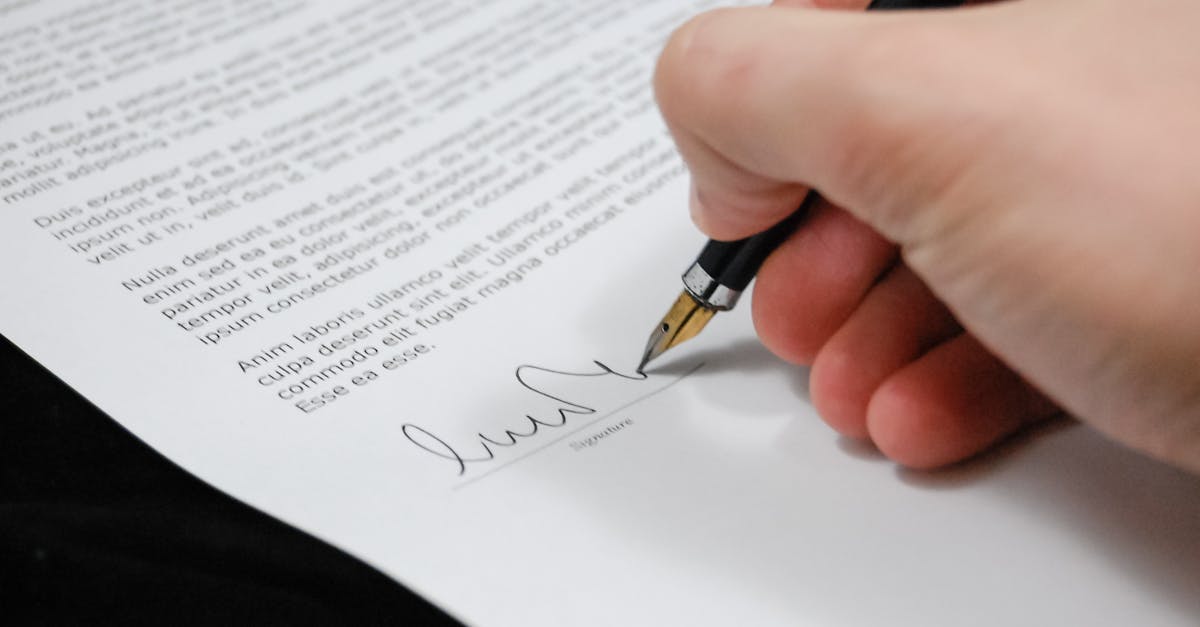
Examples of Common Legal Documents That Can Be Handwritten
Drafting legal documents by hand is a practice that dates back centuries and is still applicable in certain situations today. One common legal document that can be handwritten is a will. While many people opt to create wills using online templates or through legal software, hand-crafting a will can add a personal touch and authenticity. By putting pen to paper, individuals can ensure that their final wishes are clearly stated and free from any ambiguity that might arise from digital formats.
In addition to wills, contracts are another type of legal document that can be handwritten. While larger contracts involving significant financial transactions or complex terms should ideally be typed to ensure clarity and accuracy, small agreements between individuals can be effectively handwritten. Taking the time to draft a contract by hand can demonstrate a level of commitment and earnestness that might be lacking in a printed document. Moreover, it allows for greater flexibility in negotiations and revisions, as changes can be made directly on the paper during the drafting process.
Wills, Contracts, and Power of Attorney Documents
Drafting legal documents such as wills, contracts, and power of attorney documents by hand is a practice that raises certain considerations and challenges. While it may seem personal and traditional to handwrite these important documents, there are potential risks involved. Handwritten legal documents, especially wills, can sometimes be contested in court if there are uncertainties or inconsistencies in the language or if the testator's intentions are vague.
On the other hand, when it comes to contracts and power of attorney documents, the precision and clarity of the language used are paramount. Handwriting these documents might lead to misinterpretations and legal disputes due to illegible handwriting or improper phrasing. It is crucial to remember that legal documents hold significant weight in legal proceedings, and any ambiguity or errors could result in serious consequences.
Best Practices for Handwriting Legal Documents
Drafting legal documents requires meticulous attention to detail, as any errors or inconsistencies could potentially lead to confusion or legal disputes. One of the best practices for handwriting legal documents is to ensure thorough proofreading for any mistakes. This includes checking for spelling errors, grammatical mistakes, and ensuring that all information is accurate and consistent throughout the document. Missing or incorrect information could result in serious consequences, so taking the time to meticulously review the document is crucial.
In addition to proofreading, another important practice when handwriting legal documents is to maintain a professional tone and language throughout the document. Using clear and concise language will help ensure that the document is easily understood by all parties involved. Avoid using overly complex language or jargon that may confuse the reader. By following these best practices, you can help minimize the risk of misunderstandings and errors in your handwritten legal documents.
Proofreading for Errors and Consistency
After drafting legal documents by hand, it is essential to thoroughly proofread them to ensure accuracy and consistency. Errors in legal documents could lead to misunderstandings, disputes, or even legal ramifications. By carefully reviewing each word and sentence, you can identify spelling mistakes, grammatical errors, or inconsistencies that may have been overlooked during the initial drafting process. Proofreading also allows you to confirm that the information provided is complete and includes all necessary details for the document to be legally binding and executable.
Consistency is another critical aspect to consider when proofreading handwritten legal documents. Ensuring that the terminology, formatting, and language used throughout the document remain uniform is essential for clarity and coherence. Inconsistencies in language or formatting could cause confusion for the parties involved or potentially render certain clauses ambiguous or open to interpretation. By maintaining a consistent style and tone throughout the document, you can help convey your intentions clearly and reinforce the validity and professionalism of the legal document.
Legal Precautions When Handwriting Documents
Drafting legal documents by hand requires careful attention to detail to ensure accuracy and legality. One critical precaution to take is to make sure that the language used is clear, consistent, and free of any ambiguities. Ambiguous language in legal documents can lead to misunderstandings and potential disputes in the future, so it is essential to be as precise as possible in expressing the terms and conditions of the agreement being documented.
Another crucial aspect to consider when handwriting legal documents is the use of proper legal terminology and formatting. Legal documents have specific language and structure requirements that must be adhered to in order to be valid and enforceable. Using incorrect legal terms or failing to follow the proper formatting guidelines can render the document null and void, so it is advisable to consult with legal professionals or resources to ensure that the document is correctly worded and presented.
Consulting with Legal Professionals for Accuracy
When it comes to drafting legal documents, consulting with legal professionals is paramount for accuracy and validity. Lawyers and legal experts possess the necessary knowledge and experience to ensure that the content of the document adheres to legal standards and requirements. Additionally, legal professionals can provide valuable insights and recommendations on how to structure the document effectively to achieve the desired legal outcomes.
Legal consultations can help in clarifying any ambiguities or uncertainties that may arise during the drafting process. By seeking input from legal professionals, individuals can gain a better understanding of the legal implications of the document and make any necessary adjustments to ensure its legal soundness. Ultimately, consulting with legal professionals for accuracy can help in avoiding potential legal disputes or challenges in the future.
FAQS
Is it legal to handwrite legal documents?
Yes, it is legal to handwrite legal documents as long as they meet all the necessary legal requirements.
What are some examples of common legal documents that can be handwritten?
Common legal documents that can be handwritten include wills, contracts, and power of attorney documents.
What are some best practices for handwriting legal documents?
Some best practices for handwriting legal documents include proofreading for errors and ensuring consistency in formatting and content.
Are there any legal precautions to consider when handwriting documents?
It is important to consult with legal professionals to ensure accuracy and compliance with relevant laws and regulations when handwriting legal documents.
Can I rely solely on handwritten legal documents without consulting a legal professional?
It is always recommended to consult with legal professionals when drafting legal documents to ensure that they are legally binding and meet all necessary requirements.







